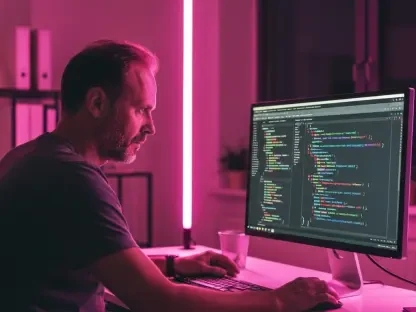In the ever-evolving landscape of remote work, software developers face a mounting challenge that threatens their ability to produce high-quality code: the relentless scheduling of virtual meetings through platforms like Zoom, which significantly disrupts the deep concentration they need to thrive. As organizations increasingly rely on digital tools to bridge the gap between distributed teams, the unintended consequence has been a notable disruption to the “flow state”—that elusive mental zone where developers solve complex problems with clarity—often shattered by the ping of a meeting invite. This issue, rooted in the clash between managerial and maker schedules, has sparked a broader conversation about how technology, while facilitating communication, can inadvertently undermine productivity. Exploring this tension reveals not only the fragility of focused work but also the urgent need for strategies to protect it in a world where virtual gatherings have become the norm.
The Clash of Schedules in a Remote World
The fundamental conflict between developers and managers lies in their differing approaches to time management, a tension that has been magnified by the rise of remote work. Developers often require long, uninterrupted blocks of time to immerse themselves in coding, debugging, and creative problem-solving—tasks that demand a high level of focus. In contrast, managers tend to operate on a schedule filled with shorter, frequent interactions to coordinate teams and oversee progress. Tools like Zoom have made it incredibly easy to schedule these interactions, often without considering the impact on those who need sustained focus. What might seem like a quick check-in to a manager can derail an entire afternoon for a developer, as the mental shift required to re-enter a flow state is neither quick nor guaranteed. This disconnect has grown more pronounced as remote work normalizes virtual meetings, creating a culture where interruptions are not just frequent but expected.
Compounding this issue is the perception that virtual meetings carry a lower cost of participation, leading to an overabundance of invites and attendees who may not need to be present. The ease of clicking a link to join a Zoom call has lowered the barrier to scheduling, often resulting in gatherings that lack clear purpose or actionable outcomes. For developers, this means more than just lost time; it represents a fracture in the delicate process of building complex solutions, akin to halting construction midstream. The frustration is palpable as these professionals struggle to protect their most productive hours from being sliced into fragments by back-to-back calls. While remote work was once heralded as a way to minimize office distractions, the reality has shifted toward a digital environment where interruptions are just a notification away, challenging the very foundation of focused, deep work.
The Impact of Meeting Culture on Deep Work
The detrimental effect of frequent meetings on developers’ productivity cannot be overstated, particularly when considering the mental toll of context-switching. Each time a developer is pulled away from coding to attend a virtual meeting, the intricate web of thoughts and problem-solving strategies they’ve built is at risk of collapsing. Rebuilding that mental framework after a disruption often takes far longer than the meeting itself, effectively turning a 30-minute call into hours of lost productivity. This phenomenon is especially pronounced in the remote era, where Zoom and similar tools have made it effortless to summon entire teams for discussions that could often be handled through written updates. The result is a workforce of developers who find their most valuable asset—uninterrupted time—slipping through their fingers with each new calendar invite.
Beyond the immediate loss of focus, the broader cultural shift toward over-scheduling has fostered an environment where meetings are seen as the default mode of collaboration, often at the expense of efficiency. Developers frequently report feeling drained by the sheer volume of virtual interactions, many of which include unnecessary participants or lack a defined agenda. This inefficiency not only hampers individual output but also impacts team morale, as the value of deep, thoughtful work is overshadowed by the need to appear engaged on screen. The metaphor of a flow state as a fragile structure, easily toppled by the slightest interruption, captures the essence of this struggle. As remote work continues to dominate, the challenge lies in recognizing that not every issue requires a synchronous discussion and that preserving focus is as critical to project success as any strategic update delivered via video call.
Strategies to Protect Developer Focus
Addressing the disruption caused by excessive virtual meetings requires a proactive approach from both developers and managers to redefine workplace norms. Developers can take steps to safeguard their productivity by blocking off significant portions of their calendars for focused work, signaling to colleagues that these periods are non-negotiable. Additionally, advocating for asynchronous communication tools like Slack allows for updates and feedback to be shared without the need for real-time interaction, giving developers the flexibility to engage on their own terms. Such measures empower individuals to maintain control over their schedules, ensuring that the deep concentration needed for coding isn’t constantly at risk of being interrupted by a sudden Zoom call. The key is to establish boundaries that prioritize uninterrupted time as a core component of their role.
Managers, meanwhile, play a crucial role in curbing the meeting overload by critically assessing the necessity of each gathering and exploring alternative ways to share information. Scheduling meetings at the start or end of the day, when possible, minimizes disruption to prime working hours, while designating specific days or even weeks as “no-meeting zones” can provide developers with much-needed breathing room. Reducing the number of attendees to only those essential to the discussion further streamlines these interactions, ensuring they are purposeful and concise. By fostering a culture that values written updates over video calls for non-urgent matters, managers can help preserve the sanctity of deep work. This collaborative effort to rethink scheduling practices reflects a growing understanding that productivity hinges on protecting focus and that virtual tools should serve as enablers of efficiency rather than sources of constant interruption.
Balancing Collaboration with Uninterrupted Productivity
Looking back, the pervasive meeting culture, amplified by platforms like Zoom, posed a significant barrier to developers’ ability to maintain their flow state. The ease of scheduling virtual calls often led to an overreliance on synchronous communication, sidelining the critical need for uninterrupted time to tackle complex coding challenges. The tension between managerial needs and developers’ workflows became a defining struggle, with many teams grappling to find equilibrium in a remote-first environment. Reflecting on these challenges, it was evident that the tools themselves were not the sole issue, but rather the norms and expectations surrounding their use needed reevaluation to prevent productivity from being eroded by frequent disruptions.
Moving forward, the path to balance lies in actionable steps that prioritize both collaboration and focus. Teams should commit to regular reviews of meeting frequency and purpose, ensuring that each gathering adds tangible value. Embracing hybrid communication models—blending asynchronous updates with minimal, well-structured video calls—can help maintain necessary interactions without sacrificing deep work. Developers and managers alike must champion a shift in mindset, viewing uninterrupted time as a strategic asset rather than a luxury. By integrating these practices into daily operations, organizations can foster an environment where technology supports productivity rather than undermines it, paving the way for innovation to flourish amidst the demands of remote collaboration.









